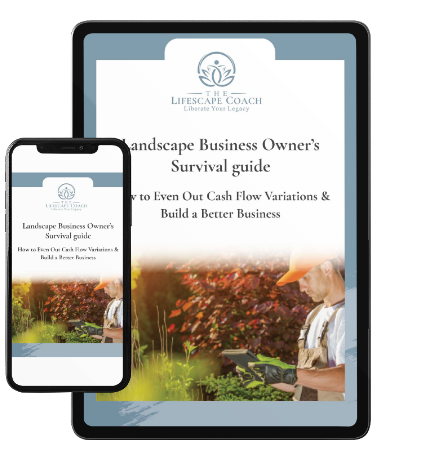4 Massive Mistakes Landscape Companies Make in Their Marketing & Sales Messaging and How to Avoid Them
Landscape business owners – like a lot of business owners – spend a considerable amount of time and money crafting traditional sales and marketing tools such as truck signage, brochures, and now websites.
However, more often than not, it’s not the marketing tools that fall short when it comes time to deliver – it’s the service itself. Time and time again, landscape companies make big promises on what they’ll do for their customers but fail to deliver, resulting in unhappy clients and stalled growth.
In most cases, the problem can be traced back to a single fundamental shortcoming: poor communications. And it usually starts with a business owner unable to articulate what they do, why they do it, and how. Clarity – or lack thereof, to be precise -- is at the heart of four massive mistakes landscapers often make that costs them time, money, and clients. Let’s take a close look at those four mistakes so you can avoid them:
1. Unclear communications
Before you do anything else, get clear on what you do, why, and how you do it. Many landscape business owners fail to communicate clearly with prospects. They have no real idea of why a prospect should pick them over their competition other than some fuzzy notion that “we’re better.”
It’s crucial that you determine, first and foremost, WHY you are in business, WHAT value you will deliver to clients, and HOW you will deliver it. This is your mission. This is why you get up every day.
Here’s a suggestion: Once you feel clear, in your own mind, about what you do that’s different from your competitors, why prospects should use you instead, and what service you will deliver consistently – write it down. Write it down again. And again. And again. Get it so you can repeat your mission in your sleep. This will be central to everything you do and say.
2. Assuming clients understand what you do
The truth is, prospects don’t know what you offer as a business and won’t know until you tell them. And then, you may still have to remind them once or twice. So, after getting clear in your own head by addressing Mistake #1 above, it’s time to clue potential clients in.
Start with the basics – are you a general service provider who does a little bit of everything or are you more specialized, offering one or two services at which you are an expert? Whatever it is that you offer, stick to it. Don’t fall prey to feeling that you have to say ‘yes’ to something, anything, just to get business from a client. Chances are good that you will not deliver well if you say yes to something you might not typically do. In the end, the client is disappointed, you may not get any more business from them, and you both end up losing out.
When communicating with prospects, remember not to focus on the means – focus instead on the results. For example, you may mow and fertilize lawns, but what you really deliver is professionally cared-for, lush, healthy lawns that are a source of pride for clients and envy for neighbors. Now, THAT’S a service worth paying for.
3. No fully-developed process for delivering services
 Now that you know WHY you are in business and you know WHAT you do, it’s essential that you understand HOW you do it. What do your services look like? How are they organized, categorized, sold, and delivered? Does everyone in your organization understand this? Can they easily share this with clients?
Now that you know WHY you are in business and you know WHAT you do, it’s essential that you understand HOW you do it. What do your services look like? How are they organized, categorized, sold, and delivered? Does everyone in your organization understand this? Can they easily share this with clients?
Crafting service packages that are outlined in your marketing, your sales, and your delivery channels will ensure that no bait-and-switch occurs. I realize that most service providers don’t do this intentionally. Unintentional bait-and-switch occurs more commonly when a landscape business owner is eager to agree to something with the client and ends up fudging what that something is, providing instead a service that may not be what the client originally wanted. It’s what often happens when clarity and communication are missing.
By standardizing processes and pricing, you create a “product” that’s easier to understand and sell. You end up with a standard product that you can train new employees on and that they can feel confident selling and discussing with clients. Clients know what they’re getting and what they’re paying for. Sales improves, service improves, and client satisfaction improves. Everybody wins.
4. No clear pricing strategy
Pricing is a perennial problem for many service providers, regardless of industry. The fact of the matter is, you cannot go into business – any business – with a wishy-washy sense of your price points and expect to be truly successful.
While many landscape companies work on a time-and-materials basis, it’s also a good idea to think in terms of annual service packages for clients. This helps you and the client think about the big picture investment and making a commitment to a level of work that can have a significant, lasting impact.
When considering pricing, always keep in mind the end results – what will the client ultimately gain from working with you? What will be different for them? Your job is to link your services and the client’s investment with a positive outcome and experience. The tangible benefits the client will enjoy by working with you is what provides value and sets you apart from the competition, giving the client good reason to come back to you, year after year.
“If the client ain’t happy, ain’t NOBODY happy.”
Service providers such as landscape companies now operate in a relationship market. The internet, social media, and every manner of app and smart device provide endless ways to connect with our clients. This creates a new level of heightened expectations and a demand for deeply satisfying experiences. Delivering all of that is key for developing meaningful client relationships and, ultimately, loyalty.
It’s simple: service providers live and die by the service they provide. In the end, the client experience is the number one indicator of success. When you fail to communicate your value, your services, and your pricing clearly, you run the real risk of disappointing the client. All the beautifully manicured lawns, lush and colorful flower displays, and well-designed hardscapes won’t mean a thing if they do not meet client expectations. If the client isn’t happy, you didn’t do your job. Simple as that.

Landscape Business Owners Survival Guide


